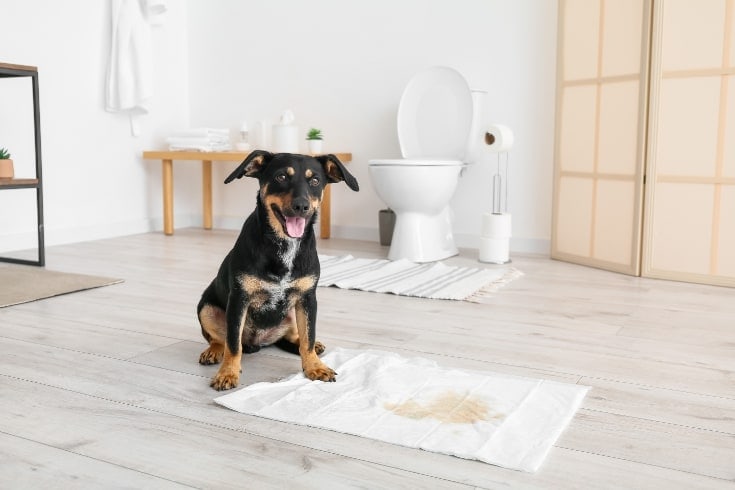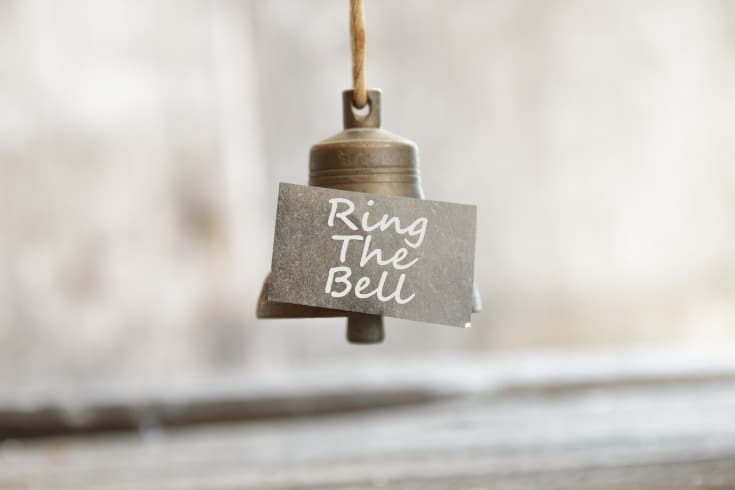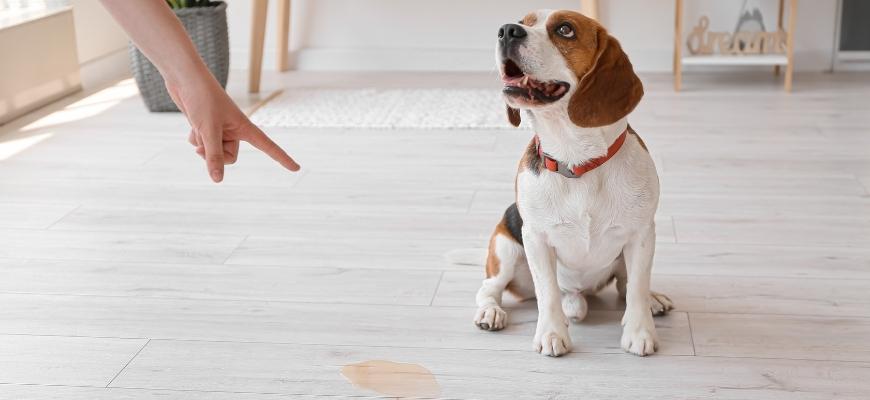If you’ve decided to welcome an unwanted dog from a rescue or shelter into your life, good for you!
But one of the most important things for most pet parents when taking on a new furry friend is teaching your pet to relieve himself in a designated spot, ideally outside.
House training a rescue dog can be more challenging than potty training a puppy from a breeder.
Read this guide to learn how to successfully house-train a rescue dog.
How to House Train Your Rescue Dog

It’s essential that you begin potty training your rescue dog as soon as you get him home. That way, your dog won’t be confused, and you can minimize accidents.
Potty training an unvaccinated puppy can be challenging as you’ll need to keep your pet away from other dogs in your backyard or outside space.
Here are some top tips on how to house-train a rescue dog.
Previous Experience
If you’re lucky, your rescue dog will have some experience of potty training in his previous home, making him easy to house train after a few false starts.
My second rescue dog had a couple of minor accidents when she first arrived at my home, but it soon became obvious that she had once been house-trained. As soon as my pet understood where the back door was, she always asked to go outside to relieve herself.
When you collect your rescue dog, your first task is to take him for a short walk so that he can relieve himself if he needs to. Usually, the excitement of meeting his new owners, taking a ride in a car, and arriving in a new place is enough to stimulate your dog to need a pee at least.
Peeing on things is also your dog’s way of marking his new territory and showing other dogs that he’s around. So, head for your garden and pick a suitable place that your dog can adopt as his regular potty spot.
How Long Can Your Dog Hold It?

Before you begin the house training process, you need to know how long your new canine companion can wait between bathroom visits.
If you’re around at home and your dog is out of his crate, how long does your pet typically last before he needs to go outside? What about nighttime potty visits? Does the dog ask to go out, or does he just soil his crate or your room? When do accidents usually happen – during the day, while you’re out of the house, when you’re there, or only at night if your dog is allowed to roam free?
As a general rule of thumb, young puppies can usually wait for one hour per month of age. So, if you have a 6-month-old puppy, he will need to go potty every 6 hours or thereabouts.
No dog, regardless of his age, should be expected to wait more than 8 hours for a bathroom break.
Create a Schedule
Once you know roughly how long your dog can last between potty stops, you can devise a potty schedule.
Dogs and puppies generally need to relieve themselves as follows:
- Immediately after waking up in the morning
- On waking after a nap
- After playtime or exercise
- After eating a meal
That’s assuming the dog has no health problems, which means he needs to go more often.
A simple bathroom break schedule for an adult rescue dog could be:
- Potty stop first thing in the morning upon waking up
- Trips outside for a bathroom break every couple of hours throughout the day
- Bathroom break following playtime
- Bathroom break following meals
- Final bathroom break before going to bed at night.
Of course, if your dog asks to go outside, you must take him out when he needs to go. If you ignore your dog’s requests, you’re risking him having an accident that could set back your potty training efforts.
Choose Verbal Cues

Basic training and potty training are made much easier if you teach your dog to respond to clear, simple verbal cues.
So, every time you take your dog outside to relieve himself, use a cue word, such as “go potty.” Your dog will quickly understand what you mean and should go ahead and perform.
Exercise Your Dog
Exercise can help with potty training.
I always take my dogs out for a walk as soon as we get up in the morning. The dog can do her business while I’m walking her, preventing an accident in the house and helping to create a regular potty routine.
Use a Crate
Many people find that using a crate makes potty training a rescue dog much easier than taking the “free range” route.
Dogs won’t willingly soil their sleeping area in the den. So, if you provide your dog with a cozy, well-equipped crate with a comfortable bed and some toys, he will hold his bladder and bowel until you let him out.
Until a dog is fully house trained, accidents most commonly tend to happen overnight if the dog is allowed to roam around your home and you’re not there to watch him.
So, crating your dog at night makes potty training easier.
Ring My Bell!

Although it sounds a little far-fetched, you can train your dog to ring a bell when he wants to go out!
Fix a bell on a piece of string beside the door. Each time you take your dog outside for a potty stop, ring the bell. Amazingly, your dog will quickly begin to ring the bell when he needs to go!
Positive Reinforcement and Praise
Whenever your dog goes potty in the allotted, approved place, reward him with praise and high-value treats. Once the deed has been done, offer your dog a game with his favorite toy to show him how pleased you are with his behavior.
Positive reinforcement methods are proven to be more successful than negative ones in every aspect of dog training. So, use that knowledge to make life easier for you and your dog.
How to Deal With Potty Accidents

Unfortunately, potty accidents are bound to happen, no matter how vigilant you are.
If your dog has an accident, do not punish or scold him. Remember that your dog is still learning. If your pet makes a mistake and you shout at him, you risk frightening your furry friend and damaging the bond you’re trying to form between you.
In addition, your dog probably won’t understand what he’s done wrong if the accident occurred while you were out. Yelling at your dog after the fact will achieve nothing positive.
Rescue dogs often come with an uncertain history. You don’t know whether your dog has had bad experiences with his previous owner. If you scold your dog, he might even become aggressive.
The best thing to do is clean up the mess and don’t make a big deal out of the accident. Take your dog outside and give him the opportunity to relieve himself if he needs to. That will reinforce the desired behavior that you want.
Cleanup
Wherever the accident happens, be sure to clean up thoroughly.
Dogs are scent-oriented animals, and if your dog can still smell the odor of urine or feces, he will probably return to the scene of the crime. So, to prevent a repeat offense, you need to get rid of the smell completely.
Enzymatic, pet-friendly cleaners are often effective. But you might need to fence off the affected area with baby gates, or something similar to keep your dog away until the designated potty spot that you want your pet to use is established.
FAQs
In this part of our guide to house training a rescue dog, we answer some of the most frequently asked questions by pet parents who are thinking of adopting a dog from a shelter or rescue.
How long does it take to house-train a rescue dog?
The length of time it takes to house train a rescue dog depends on the dog’s age, size, breed, and whether he has been potty trained previously.
Smaller breed dogs can’t usually last as long as larger ones and can be more difficult to potty train. Dogs that have lived on the streets and companion breeds also tend to be harder to house-train.
However, you can usually house-train an adult rescue dog in around two weeks or a little longer.
How do I stop my rescue dog from peeing in my house?
If you have an adult dog that insists on peeing in your house, it could be that he is trying to mark his territory. Scent marking in dogs that have not been spayed or neutered is typically more common than in those pups that are desexed. So, a trip to the vet for minor surgery to desex your pet could help.
If you catch your rescue dog peeing in your house, quickly distract him by clapping your hands or making some other kind of noise to startle him. Don’t scold the dog. Immediately take him to his designated toilet place, praise him, and reward him with a treat if he finishes the job there.
Why does my rescue dog keep pooping in the house?
If your dog keeps doing his business inside your house, he might have some kind of health problem that makes it difficult for him to hold it. The change of routine from living in the shelter to living in a proper home can sometimes upset a dog’s stomach, as can a change of food.
First of all, consult your vet to rule out a medical reason for the accident.
Why is my rescue dog not peeing outside?
Some rescue dogs go through considerable trauma to reach the shelter or rescue center before coming into your life. That’s especially the case if you’ve adopted a dog from abroad. That history can mean that the dog has spent much of his time in a cage and has learned to hold his bladder for hours or even for a couple of days.
If the dog is timid, it could be the case that loud traffic noise, other dogs barking, or people passing by in the street make the dog too anxious to pee outside. In fact, if the dog waits to pee until he gets back in the house, fear of being outside is often the problem.
Sometimes, dogs that feel the cold refuse to pee outside on wet, chilly days. Some dogs are even afraid of the dark!
You need to work out why your dog won’t pee outside and then figure out a way to make him more confident.
Final Thoughts
Did you enjoy our guide to house training a rescue dog? If you found the information in the article helpful, please share it!
Some rescue dogs have previous experience in house training, making the process pretty straightforward. However, those pups that are not house-trained can be taught to use a designated potty spot within a few weeks of arriving in their new home.
You must expect a few house training accidents when you first begin your potty training journey. However, if you use positive reinforcement and reward-based training methods, you’ll succeed in the end.
Did you house-train your rescue dog? Tell us about your experience in the comments box below. And don’t forget to send us a photo of your furry friend!
